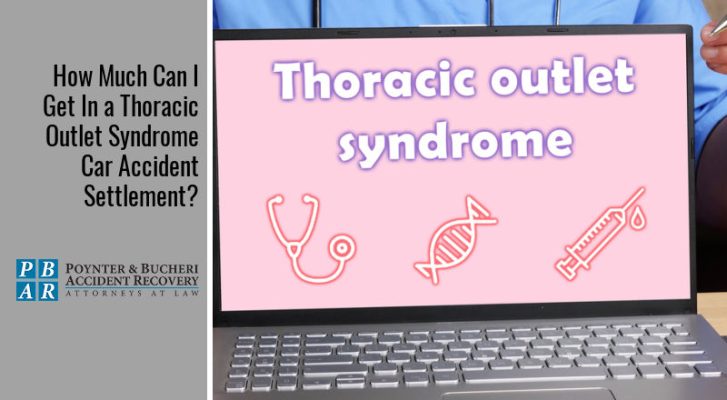
How Much Can I Get In a Thoracic Outlet Syndrome Car Accident Settlement?

What is Thoracic Outlet Syndrome?
Thoracic outlet syndrome (TOS) is a group of disorders that happen when the nerves and/or blood vessels in the thoracic area are injured or compressed. You have probably heard the term thorax used to describe the part of the body between the head and the abdomen; in other words, the chest. The thoracic outlet is a narrow space between the collarbone and the first rib. When the nerves, arteries, or veins are compressed in this outlet, it can lead to numbness, pain, and weakness.
Although TOS can be caused by repetitive motions (which is why so many pitchers are afflicted with it) and congenital issues, it can also be caused by the physical trauma of a motor vehicle accident. To receive any type of thoracic outlet syndrome car accident settlement, you must first get a TOS diagnosis.
Unfortunately, the symptoms aren’t completely clear-cut. Doctors may arrive at several other diagnoses, such as angina, rotator cuff injuries, multiple sclerosis, or fibromyalgia before eventually narrowing the injury down to TOS.
There are three types of thoracic outlet disorder:
Neurogenic thoracic outlet syndrome
- This is the most common type of TOS, comprising 95% of all cases.
- The base of the thumb on one hand in particular seems to waste away.
- There is a feeling of pins and needles in the fingers and the hand.
- One hand may be a different color or feel colder than the other hand.
- The patient feels an aching pain in the neck, shoulder, or armpit.
- The neck, chest, or arms feel weak or numb.
Venous thoracic outlet syndrome
- This occurs in 4-5% of cases of TOS.
- Damage to veins in the upper chest or lower neck creates blood clots.
- There is swelling of the hands, fingers, and arms.
- The neck and arms may feel weak.
- The damaged arm may have a weak pulse and seem paler than the other arm.
- The patient may experience numbness, weakness, and tingling.
Arterial thoracic outlet syndrome
- This is the rarest type of TOS, occurring in only 1% of cases.
- It is usually a congenital condition caused by a bone abnormality that compresses an artery.
- Hands and fingers may feel heavy, sensitive to cold, tingling, or numb.
- Fingers may also swell.
How is TOS diagnosed?
You may have to see a thoracic surgeon, neurologist, or vascular surgeon who will examine you physically before administering various tests. Many of the tests are simply to rule out other problems. According to Cleveland Clinic and the NIH, tests for TOS may include:
- Nerve conduction studies
- Vascular studies
- Chest X-rays
- Cervical spine X-rays
- CT scan (computerized tomography)
- MRI (magnetic resonance imaging)
- MRA (Magnetic resonance imaging with angiography)
- Arteriogram or venogram
- Blood tests
- Adson test
- Elevated arm stress test
- Upper limb tension test
How is TOS treated?
- Usually, TOS is treated first with physical therapy. Patients are taught proper posture and stretching techniques. They develop a better range of motion and work to keep pressure off their shoulders.
- Patients are often advised to take pain relievers such as ibuprofen, acetaminophen, or muscle relaxers.
- In the rare cases of venous or arterial TOS, patients may be prescribed anticoagulants to break up blood clots.
- In some cases, (10-20%) surgery may be required.
Can a car accident cause thoracic outlet syndrome?
Yes, a car accident can cause thoracic outlet syndrome. In fact, it is a common cause. According to the NIH, “Hemorrhage, hematoma or displaced fracture can directly compress the nerves or vasculature.” One cause that is particularly mentioned is a fracture of the clavicle (collarbone). Whiplash injuries are also strongly associated with TOS.
Any type of physically traumatic event can cause TOS, and car accidents fall into this category.
Can I get compensation for a thoracic outlet syndrome injury after a car accident?
In order to be compensated in a thoracic outlet syndrome car accident settlement, you will need to be able to prove several things, none of them simple or clear cut.
- First, you will need to prove that the other person’s negligence and lack of care caused your accident, or at least contributed to it in a major way. Under Indiana’s modified comparative negligence statute, you must be less than 51% at fault in an accident to file a personal injury claim.
- You will need to prove that you have thoracic outlet syndrome. This is easier said than done because many doctors are slow to recognize this syndrome or to formally diagnose it. You will need to be persistent in your quest for a diagnosis, and you will need to keep all medical records. It may be helpful to keep a journal documenting your symptoms and pain levels.
- Not only will you need to prove that you are suffering from thoracic outlet syndrome (TOS), but you will also need to prove that the motor vehicle accident is what caused it. This is tricky, because the symptoms may not have manifested themselves immediately after your accident. There is often a delay in the onset of symptoms.
- Finally, you will need a car accident attorney who is knowledgeable about TOS and who can explain its complexities to an insurance representative, or perhaps even a judge and jury.
A thoracic outlet syndrome car accident settlement is possible, and the team at Poynter & Bucheri will fight aggressively for your right to be fairly compensated.
Learn more about your legal rights and the compensation you deserve for your accident claim by calling the Law Office of Poynter & Bucheri at 1-800-265-9881 or (317) 780-8000 to request your free consultation with an Indianapolis personal injury lawyer.
